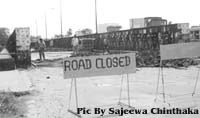 |
 28th June 1998 |
Front Page| |
Closing bridges, building bridgesBy Tharuka DissanaikeA long, crawling traffic block. Stretching over two kilometres. Motorists inching their vehicles forward. Errant private bus drivers taking over the opposite lane. Horns blaring. Private buses filled to the brim and over with tightly packed sweating bodies. Motor cyclists running over pedestrians as they clamber onto pavements to avoid the road -daring three wheelers to do the same. What if this was part of your routine every morning? Those travelling to Colombo via the Negombo road had better get used to it. Because the traffic congestion that they are experiencing now- which began when the Old Victoria Bridge closed for traffic two weeks ago- will certainly be a part of their mornings for the next two years- until the Japan-Sri Lanka Friendship Bridge is extended. To add to rush hour motorists’ misery, large container trucks and lorries are still allowed to ply the road at peak hours. The traffic block on the Negombo road lasts until as late as 10 o’clock in the morning. This too would be bearable in the short term- but there is no relief offered until the new bridge extension is completed.
At rush hour, anyday, there would be some traffic congestion. But now, with the old bridge completely out of bounds, the block has become a nightmare. The Road Development Authority maintains that the old bridge was “hardly used” and its absence cannot matter that much. They little realise that this bridge “condemned” since 1993 as unfit for heavy traffic, daily opened both its lanes for traffic that came into Colombo. “There was no option but to take the bridge off,” Director Special Projects, RDA, J.M. Chandradasa said. The bridge was corroding and crumbling. There could have been a great disaster if the bridge was left for the use of heavy vehicles.” The RDA says the present traffic congestion is not caused by the absence of the Victoria Bridge. They maintain that the two remaining bridges are designed to take more than the present volume of traffic of both roads. The Japan-Sri Lanka Friendship Bridge can accommodate 5000 vehicles an hour, both ways, Chandradasa said. “But that is when traffic is moving fast, not when there is a block on the bridge.” The RDA estimates point to an overall traffic growth of 4 percent each year. By the end of the two year construction period two more lanes will be added to the Japan- Sri Lanka Friendship Bridge. According to RDA estimates this extension will be sufficient to hold the traffic increase during the two years. RDA Chairman, W.A. Jayasinghe said the RDA had carefully planned the bridge construction. The Japan- Sri Lanka Friendship Bridge was constructed to pave the way for the eventual removal of the Victoria Bridge. Jayasinghe said this bridge extension is not the only bridge planned over the Kelani. Another four lane bridge is coming over the mouth of the Kelani at Mattakkuliya. This will provide access for traffic from Hendala and Wattala to enter Colombo North, avoiding the Negombo road. A third bridge is planned over the Kelani close to the Kelaniya Raja Maha Viharaya, crossing over to low level road. Even when the Colombo- Katunayake expressway is constructed, these bridges will be able to take the additional flow of traffic, RDA said. Transport Engineer and lecturer at Moratuwa University Dr. Amal Kumarage sees the problem differently. “The congestion on Negombo road will soon ease off as motorists adjust to the new situation,” he said. Dr. Kumarage feels that long term policy must look at developing the suburbs and leading away from the city and not into it. Most developed countries have given up the idea of expressways leading into the city, he said. “Why should Sri Lanka continue with a well proven failure,” he said, warning that Colombo might become another Bangkok if things continue as they are. |
||
 |
More Plus * Can I hear howls of protest?
Front Page| News/Comment| Editorial/Opinion| Business| Sports | Mirror Magazine |
|
 |
Please send your comments and suggestions on this web site to |
|
 There
are three main bridges used to access Colombo across the Kelani river-
the old steel Victoria bridge, the New Kelani Bridge and the Japan Sri
Lanka Friendship Bridge, which was built in 1992. Together they constitute
seven lanes of traffic moving towards Colombo and five moving out of Colombo.
(The old bridge was used only for incoming traffic). Two main trunk roads-
the Kandy road and Negombo road, bringing traffic from the North, North
Central, North Western, Wayamba and Central Provinces have to use these
bridges.
There
are three main bridges used to access Colombo across the Kelani river-
the old steel Victoria bridge, the New Kelani Bridge and the Japan Sri
Lanka Friendship Bridge, which was built in 1992. Together they constitute
seven lanes of traffic moving towards Colombo and five moving out of Colombo.
(The old bridge was used only for incoming traffic). Two main trunk roads-
the Kandy road and Negombo road, bringing traffic from the North, North
Central, North Western, Wayamba and Central Provinces have to use these
bridges.